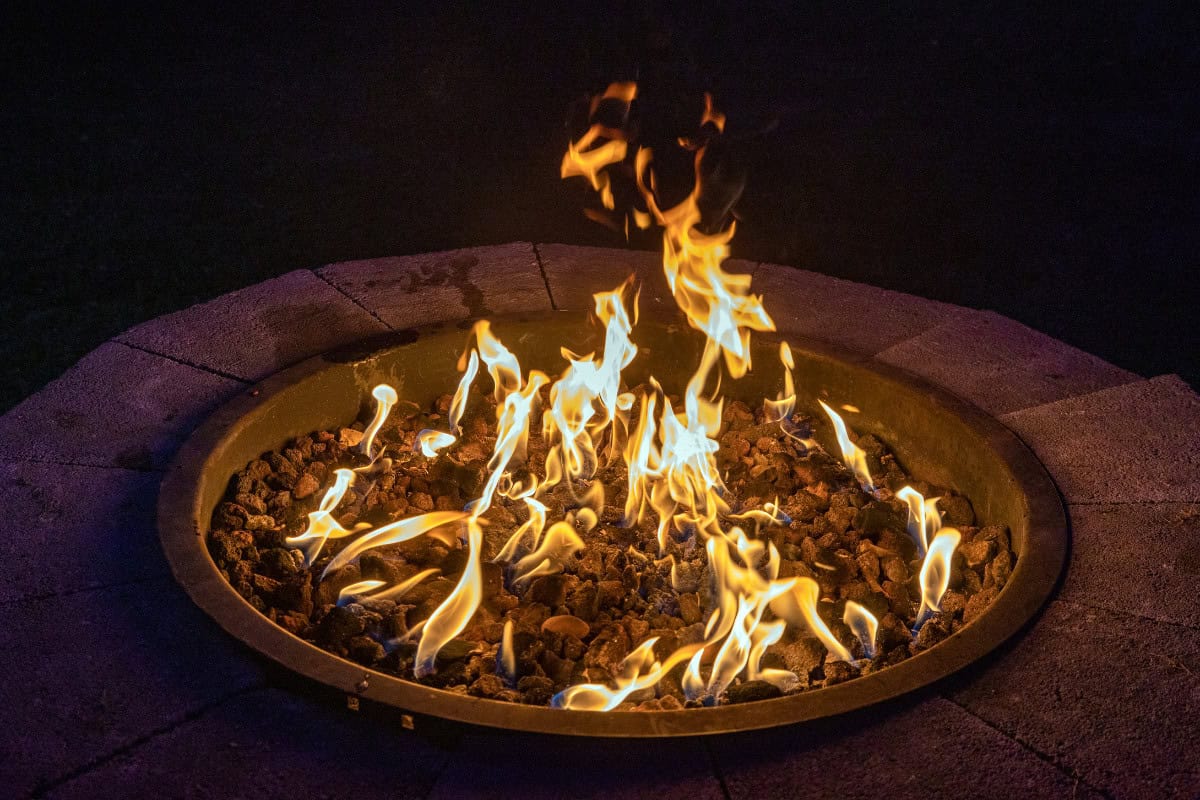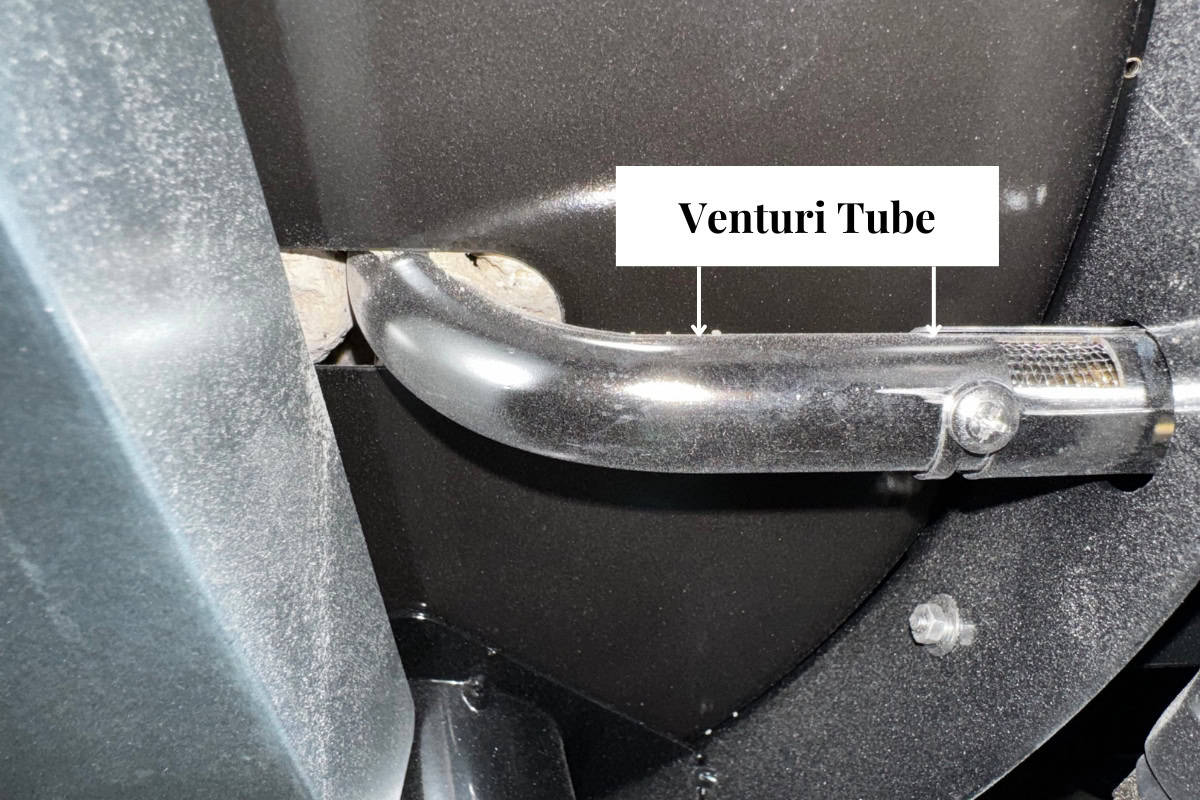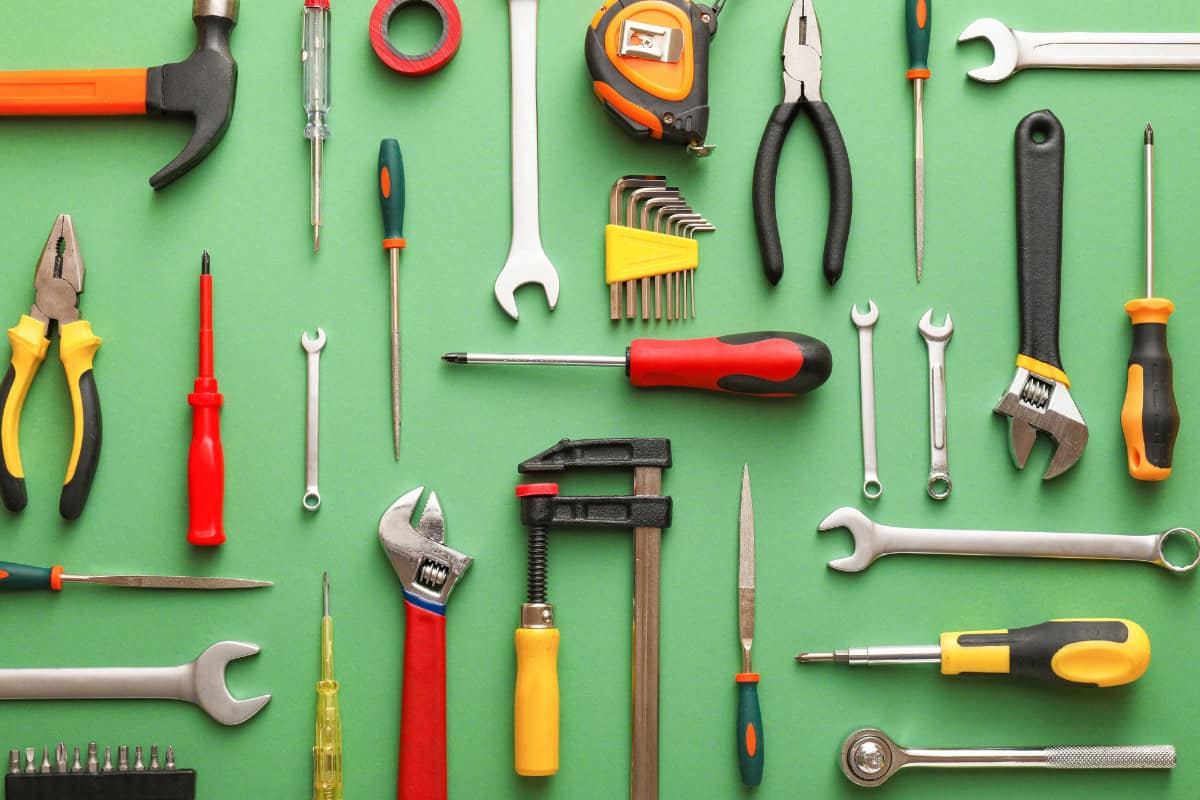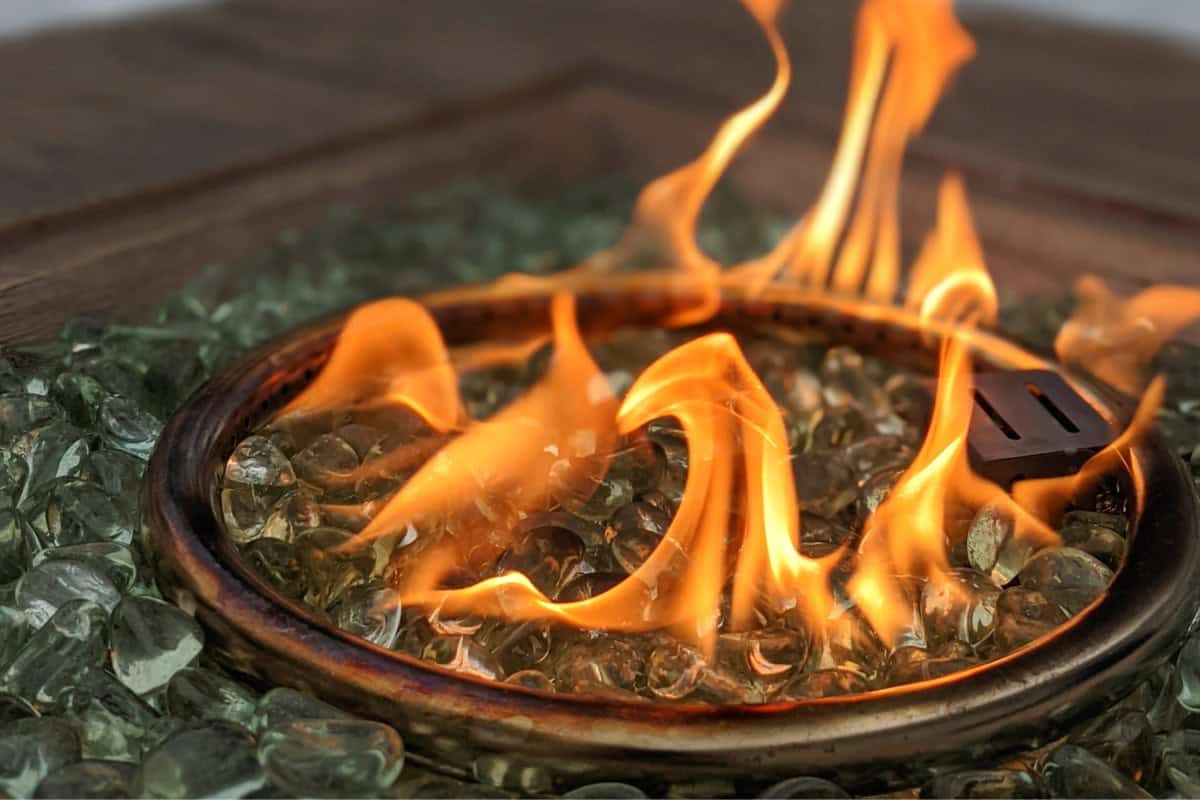
When your gas fire pit whistles during operation, it’s more than just an irritating sound—it’s usually indicating a problem that needs attention.
Most commonly, this high-pitched noise stems from improper gas pressure or substandard flex lines connecting your fuel source.
While the whistling might seem like a mere nuisance, addressing it is crucial for both safety and optimal performance.
Understanding the root causes of these whistling sounds will help keep your outdoor living space both peaceful and secure.

Common Causes of Gas Fire Pit Whistles
Are you wondering why your gas fire pit whistles?
That high-pitched sound isn’t just annoying—it’s a signal that something needs attention.
Issues with gas lines, burners, or airflow often trigger these noises. Let’s break it down.
Improper Gas Pressure
Gas pressure that’s too high or too low is a top reason for whistling sounds.
When the gas pushes through the line too fast, it creates turbulence, which causes the whistle.
Much like air blowing through a small crack, the sound becomes inevitable. Make sure the pressure settings match your fire pit’s specifications.
If you’re unsure, contacting a professional can help. Excessive pressure may also impact safety, so addressing it promptly is key.
For more information, you can check out this article on gas pressure and noise.
Air in the Gas Line
Trapped air in the gas line—not as uncommon as you’d think—mimics a similar whistling sound as improper pressure.
How does this happen? When air pockets form inside the line, they struggle to escape, resulting in a high-pitched noise.
Purging your gas line to remove air is the go-to solution. Always follow your fire pit’s manufacturer guide for the safest approach.
Learn more about troubleshooting fire pit noises in this helpful guide.
Faulty Burner Components
Certain parts within your burner, such as the orifices or jets, can develop damage over time.
When these components are even slightly defective, they disrupt the normal flow of gas, leading to that irritating noise.
Routine inspections can catch these issues early.
Replace any faulty parts immediately to restore proper function.
Ignoring them only worsens the problem, and in some cases, the noise may indicate larger issues with your fire pit’s performance.
Check out additional insights on burner issues here.
Clogged Venturi Tubes
Venturi tubes mix air and gas to achieve the ideal burn.
However, when these tubes are clogged with dirt or debris, airflow becomes restricted.
What happens next? An imbalance leads to the unmistakable whistling sound.
Cleaning the venturi tubes is often enough to resolve this.
Regular maintenance will also prevent future clogging. Always turn off the gas and follow manufacturer safety protocols before cleaning.
By pinpointing these common causes, you’ll have a better idea of how to fix or prevent gas fire pit whistles in the future.
Your outdoor ambiance deserves better than an unwanted soundtrack!

Safety Considerations When Your Gas Fire Pit Whistles
A whistling gas fire pit might seem like a nuisance, but it deserves your full attention—because safety always comes first.
The sound could indicate underlying issues that, left unchecked, could pose risks to your home or loved ones.
By understanding the possible warning signs and the right steps to take, you can enjoy your fire pit safely.
Signs of a Gas Leak
Gas leaks are one of the most serious risks associated with a whistling fire pit.
Whistling might occur due to improper gas flow or damaged components, which can sometimes result in gas escaping.
Stay alert to these common gas leak warning signs:
- An unusual sulfur-like or rotten egg smell: Propane and natural gas are odorless, but manufacturers add this scent as a safety measure.
- Dead or dying plants near the fire pit: Gas leaks can suffocate vegetation close to the source.
- Hissing sounds from the gas line or connections: A steady hiss often signals that gas is escaping somewhere.
- Unusual flames: Yellow or uneven flame patterns on your fire pit could point to a problem.
If you notice any of these, assume a gas leak until confirmed otherwise.
For a comprehensive guide on maintaining safe spaces around your fire pit, check out Backyard Fire Pit Safety 101.
What to Do If You Hear Whistling
If your gas fire pit starts whistling, it’s critical to act immediately.
Ignoring the sound could escalate the issue, especially if there’s a gas-related problem.
Follow these steps to ensure everyone’s safety:
- Turn off the gas supply. Stop the flow of gas to your fire pit by closing the valve. This reduces the risk of a leak or further complications.
- Inspect connections. Look for loose fittings or damaged sections of your gas line. Tighten any loose connections, but only if you’re confident it’s safe to do so.
- Ventilate the area. If you suspect a gas leak, allow gas to dissipate by airing out your outdoor space. Never light the fire again until the issue is resolved.
- Call a professional. Enlist a licensed technician to evaluate and fix any gas fire pit problems. Gas-related issues aren’t DIY projects—they need expert handling.
When in doubt, prioritize safety over convenience. To learn more about keeping your gas pit hazard-free, check out these gas and propane fire pit safety tips or consider how proper fire pit placement options could also help reduce risks.
Maintaining a safe barrier of at least 20 feet between your fire pit and structures is another long-term safety strategy worth keeping in mind.
Acting quickly and cautiously is key anytime your gas fire pit whistles. By knowing what to look for and taking these steps, you can prevent small issues from becoming real dangers.

Maintenance Tips to Prevent Gas Fire Pit Whistling
Regular maintenance ensures your gas fire pit stays whisper-quiet and efficient.
When parts fall into disrepair, whistling isn’t far behind.
Whether it’s clogged components or loose connections, a little upkeep can prevent small issues from becoming bigger hassles.
Regular Inspection of Components
A simple routine check can stop issues before they start.
Gas fire pits have several parts—burners, gas lines, and valves—that need attention from time to time.
- Look for visible damage like cracks in the gas lines or rusted fixtures.
- Run your hand along the connections (with the gas off) to feel for loose fittings.
- Inspect burner ports, ensuring they aren’t warped or blocked.
Think of it as a wellness check for your fire pit.
Just investing a few minutes can save you from costly repairs down the road.
Need more tips on protecting your fire pit from wear? Read this guide on 5 Ways to Stop Fire Pit Rust.
Cleaning Venturi Tubes and Burners
Dirty parts are often the culprits behind noises.
Venturi tubes, which mix gas and air before combustion, can easily clog with debris over time.
Similarly, burners can collect soot and grime.
When cleaning:
- Turn off the gas supply and ensure everything is cool.
- Use a soft brush or compressed air to remove dirt from vents and burner holes.
- Avoid poking deep into the tubes or burners as this could deform them.
Keeping everything clean ensures proper airflow and optimal fuel combustion.
For general cleaning tips, check out The Ultimate Guide to Fire Pit Maintenance.
Checking Gas Connections
Loose connections or improperly installed gas lines can lead to uneven pressure—one of the main reasons gas fire pits whistle.
Always ensure connections are properly tightened, but not overtightened.
To check gas connections:
- Use soapy water to spot leaks: Apply a mix of soap and water to the joints and watch for bubbles.
- Inspect hoses and fittings: Look for wear or cracks, especially if your fire pit is exposed to changing weather conditions.
- Align connections correctly: Misaligned parts can disrupt gas flow and create whistling sounds.
If your gas fire pit is outdoors, always cover it when not in use to protect the components.
Learn more about protecting your gas pit on rainy days in this helpful post: Do You Need a Gas Fire Pit Cover?
With these simple maintenance steps, your gas fire pit will stay functional and whistle-free.
Staying proactive helps ensure you never have to deal with unwanted noise interrupting your fireside fun!

When to Call a Professional When Your Gas Fire Pit Whistles
Tackling a noisy gas fire pit on your own is fine for minor troubleshooting, but some situations demand expert attention.
Understanding when to call for professional help is essential for both safety and efficiency.
Here’s what to look out for.
Complex Repairs
Sometimes, issues with your gas fire pit dive beyond simple fixes.
If your fire pit isn’t lighting, has an uneven flame, or develops repeated problems after DIY fixes, it’s time to bring in an expert.
Licensed technicians can diagnose and repair your system safely, addressing hidden issues like internal blockages, corroded connections, or damaged valves.
Here’s what often signals the need for professional intervention:
- Gas line leaks: Dealing with gas leaks is risky, no questions asked. A professional ensures proper sealing and eliminates danger.
- Broken or damaged burner components: Burners with bends, cracks, or severe clogs often require trained eyes for repair or replacement.
- Regulator malfunctions: Regulators control gas pressure, and issues here can lead to both operational problems and safety concerns.
Experts can quickly get your fire pit back to optimal condition, ensuring long-term performance.
Excessive Gas Fire Pit Whistling
It’s one thing if your fire pit occasionally hums or whistles lightly—it’s often tied to pressure or airflow adjustments.
But persistent or loud whistling points to deeper concerns that need attention.
Think of it like ignoring a car engine light: minor symptoms could spiral into dangerous situations if overlooked.
Here’s when loud whistling calls for a professional:
- Persistent noises after replacing flex lines: If swapping out cheap flex connectors doesn’t resolve the whistling, you might have an issue that lies within the gas system itself.
- Combined signs of poor functionality: Notice irregular gas flow, uneven flames, or leaks alongside the sound? Call in qualified help immediately.
Loud or excessive whistling often suggests faulty installation.
Having an expert review gas pressure settings and inspect regulator conditions is crucial for keeping your system safe.
Need more detailed safety tips? Check out this Gas Fire Pit Safety Checklist.
Pinpointing the cause of gas fire pit whistles is no simple task when signs keep popping up.
Don’t hesitate—hiring a professional saves you time, money, and peace of mind.

Resources for Further Information
You’ve tackled the causes, safety tips, and maintenance practices for keeping your gas fire pit whistle-free.
But learning doesn’t have to stop here—there’s always more to know when it comes to fire pit care and safety.
Below are some additional resources to help you further enhance your knowledge and keep your fire pit running optimally.
Fire Pit Maintenance Tips
Routine care is essential for maintaining a quiet, efficient fire pit.
From cleaning burner ports to inspecting gas lines, these tips lay the groundwork for long-lasting performance.
Regular inspection can save money, prevent accidents, and preserve the aesthetic of your fire pit over time.
Check out this detailed guide on proper maintenance at Fire Pit Maintenance Tips.
Fire Pit Safety Rules
Safety should always be a priority when enjoying your fire pit.
The guidelines you follow now can make all the difference later.
From proper placement to understanding wind conditions, coverage in 10 Essential Outdoor Fire Pit Safety Rules offers critical insights for homeowners at every level.
For a handy safety checklist aimed at creating a safer outdoor experience, check these Fire Pit Safety Rules for more essential practices that could prove invaluable.
Expert Advice on Safe Operation
Sometimes, a guide goes above and beyond basic principles.
The folks over at Travelers Insurance have put together Fire Pit Safety Tips that cover everything from minimum placement distances to proper extinguishing methods.
This is essential reading if you’re looking to add an extra layer of security to those cozy backyard evenings.
For extra advice on when and where you can place a fire pit safely, make sure to review our helpful post about using fire pits on balconies.
Diving into maintenance and safety might seem like a lot at first, but these extra resources enhance your confidence and skills when managing your fire pit.
The time spent now could save you from unnecessary whistles—or worse—later on.


